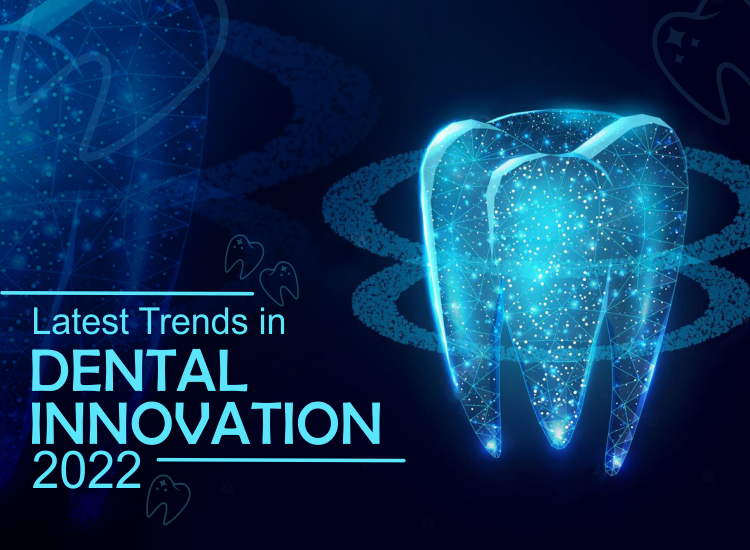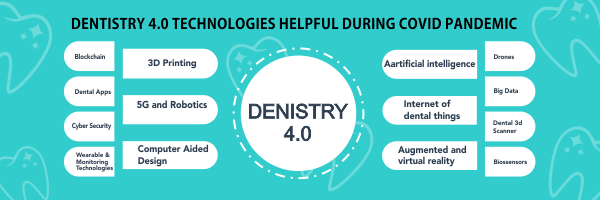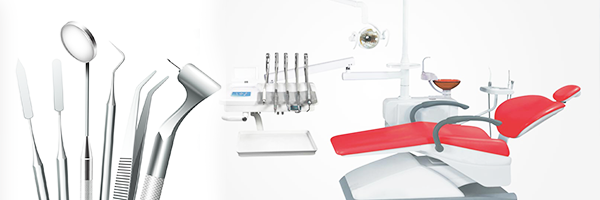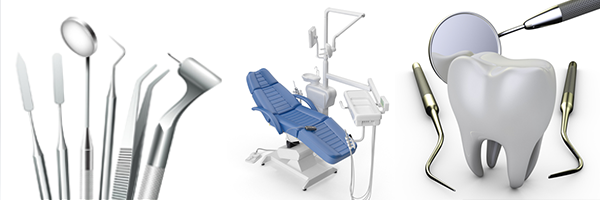
Latest trends in dental innovation 2022
A lot has changed in Innovative dental care since the implementation of AI. So, if you are a dental investor, you should know the upcoming dental innovation solutions in 2022.
The oral care industry has continued to grow and evolve through advances in technology and demand. An important area of growth within the sector was the clear aligner business. This is a USD 3.1 billion market and is expected to grow rapidly by USD 17 billion by 2028.

Oral care innovations refer to a wide range of technologies and devices that have been introduced over the last few decades, including digital or computer-controlled components, rather than purely mechanical or electrical devices. Digital technologies that can be used in dental clinics include CAD / CAM (Computer-Aided Design, Computer-Aided Manufacturing), cone-beam CT, digital X-rays, intraoral cameras, dental lasers, and optical scanners.
Recently, new innovative oral care technologies developed at NYU Dental College have been shown to significantly reduce the time it takes for patients to wear braces. This process, called microostell perforations (commonly known as faster braces), drills a small hole in the patient's gums with a special plastic drill called Propel. Controlled damage forms a porous bone tissue that allows the brace to move the tooth faster.
The rise of Dentistry 4.0
The term Dental 4.0 is consistent with Industry 4.0. Industry 4.0 uses automation and advanced computer technology to improve traditional manufacturing methods and information to improve process efficiency.
Dentistry 4.0 is the fourth dental revolution that uses new and state-of-the-art technology to better treat dental patients. Real-time data from analytically-enhanced artificial intelligence and other wearable devices powered by the eHealth recording system network is useful for dentistry. The portability of patient data allows physicians to access the data from anywhere.
Enhanced analysis helps practitioners of continuous and differential diagnosis predict timely and innovative medical responses. Dentistry 4.0 technology allows you to quickly identify areas that need improvement, so you can use your data very effectively for more informed decisions.

Due to rapid technological advances, especially during the COVID 19 pandemic, we are at the forefront of a new era in oral health innovations. Smart systems and personalization open up new possibilities for intensive care. Dentistry 4.0 offers new manufacturing possibilities and innovative problem-solving with automation, data exchange, and a variety of advanced technologies. Use the Internet of Dental Things - IoDT to connect a variety of dental tools and devices. The industry manufactures high-quality dental customization products with real-time intelligence under Dentistry 4.0 technology.
Dentistry 4.0 uses a variety of technologies to grow dentistry rapidly. With significant innovation, dentists are making better innovations during the COVID 19 pandemic. These technologies are having a major impact on how dentists treat patients and improve Innovative dental care.
The Internet of Things (IoT) allows dental devices to collect and share data using software, sensors, embedded electronics, and network connections. Manufacturing using this type of technology is becoming the Internet of Things (IoT) for the industry. To make the right decisions, the machines communicate with each other via real-time data for an accurate treatment process. This enables high-quality treatment and surgery with minimal time loss. Dentistry 4.0 opens up new possibilities by transforming traditional dental manufacturing parts that are more competitive to meet customer demands with high quality, rapid end-user response.
Dentistry 4.0 improves almost every element of advanced dental innovation solutions, from manufacturer to patient service, in the face of price, margins, product complexity, production, and strict regulatory compliance. As product complexity and complexity increase, quality risks arise. This requires improved technology with more investment and a detailed analysis of production data to improve the process. The Internet of Dental Things provides patient-centric, personalized care or equipment by combining medical devices and their applications on the Internet.
Healthcare professionals can quickly see the steps and tests performed to better treat patients. With the help of the internet, dental devices behave like cyber-physical systems, and the information in the device via sensors is more important than the device itself. Information from patients collected by smart devices via sensors helps early detection or prevention of illness by reducing the overall financial spending of the care model. Wearable ECG or blood pressure monitors are more valuable and are connected to a single central care platform for each disease continuum.
Latest Innovation of Dentistry and how they will reshape oral care
In the current scenario of a traditional medical system, if someone is sick and goes to the doctor, the next step is quick treatment. These techniques are available and will help you carry out a rapid treatment process. These technologies are limited to providing healthcare and provide access to demographic data and healthcare services for the patient's medical history and family history, lifestyle, and/or eating habits.

With the outbreak of COVID19, the demand for these technologies is increasing. Various techniques introduced in dentistry aim to improve the oral health of people in the event of COVID19. The various support software used in these technologies will help you reach a new level of digitalization. A sensor-based dental device that provides accurate information and timely alerts is connected. Virtual technology offers a variety of dental training courses that improve the teaching and learning process during the COVID 19 pandemic.
The following innovations in dentistry have had a major role during the COVID 19 outbreak and will remain an important aspect in the coming years:
Artificial Intelligence
Artificial intelligence refers to various ways in which machines are designed to operate with human-like intelligence. Combining large amounts of data with sophisticated algorithms to create machines that can perform tasks autonomously. AI is effective in healthcare by improving legacy systems and accelerating innovation. This technology plays an important role in responding to the COVID 19 pandemic. It is used in medical research and development, people's diagnosis, potential treatment testing, public health impact assessment, and more.
Internet of Dental Things – IoDT
The Internet of Dental Things is a new strategy for the prevention and treatment of tooth decay, oral malignancies, periodontal disease, and other dental disorders.
It has great promise to reach patients across more and more dental disciplines, including the following:
- Oral and maxillofacial pathology and surgery
- Prosthodontics and implantology
- Periodontology
- Oral public health
The dentist can evaluate a person's teeth based on the data collected by the camera during the brushing process. All data can be exchanged with the dentist in real-time, improving the preventive process. This gives you more freedom to do your homework, spend less time doing your homework, save space for your company, and allow your team to work in different locations.
Augmented and Virtual Reality
These techniques can be successfully used in dentistry to create suitable advanced 3D imaging of human teeth and other parts. Offsite and face-to-face training can benefit from augmented reality and virtual reality images. In addition, they are sold as long-term solutions for content collection, development, and delivery. VR technology is bringing new features to the market such as eye-tracking, hand tracking, and high-resolution headsets.
Computer Aided Design (CAD)
CAD software requires you to log in to a specific machine that facilitates design work and assists in the adjustment of numerous medical devices to offer an Innovative dental care. During the COVID-19 pandemic, individuals need to be able to work from home without significantly impacting their business operations. This allows designers to connect from home to their office computer and continue working as usual.
5G Technology
5G ought to be advertised as a telecommunications revolution as a way to revolutionize the healthcare remedy method and permit the IoT to analyze and are trying to find trustworthy, secure, and long-time period solutions. The 5G-primarily based IoT atmosphere is a community of related gadgets that use the 5G community. The benefits of the 5G community encompass new technological abilities that grow productiveness as compared to in advance cellular technologies.
Robotics
Robotics is essential in the fight against the COVID-19 pandemic. Such innovations in dentistry are used to treat patients in medical facilities and reduce human-to-human contact. It delivers goods to people to keep a social distance. COVID19 has shifted its focus to visually controlled robots, reducing unnecessary human contact in medical facilities and hospitals. Many hospitals implement food delivery robots, sterility robots, and direction guidance robots to guide patients.
3D Printing
Every day, 3D printing companies around the world are committed to helping in the fight against the COVID 19 pandemic. COVID19 is influencing the healthcare business associated with the manufacture of various medical devices to ensure the safety of the COVID19 pandemic. Customized medical tools and equipment can be easily printed using this technology.
Wearable and monitoring technology
These oral health innovations are designed to track, collect, and monitor user health data, from steps and calories burned to heart rate, sweat levels, blood glucose, stress levels, and even oxygen saturation levels. Originally, fitness trackers were designed to measure steps, heart rate, and calories burned, followed by training recommendations. Smartphones are now recognized as a useful medical tool with various functions such as heart rhythm assessment, blood pressure assessment, and daily physical activity assessment. This allows the device to monitor and analyze the relationship between daily activity and blood pressure measurements. Practitioners can use these technologies to instantly capture relevant and accurate data and act faster. Smart devices help identify health problems early and lead to better patient care. Wearable technology provides an intelligent means of monitoring a wide range of physiological variables and offers a wealth of healthcare opportunities.
Smart application
Smart apps are software that use historical and real-time data to help users make important decisions. Predictive analytics and prescriptive analytics, customer data, intelligent integration of product insights and applications enable these apps to take advantage of continuous learning techniques. It provides predictions and decisions to provide users with a very rich and personalized experience. Provides coordinated contextual material to facilitate continued engagement. It analyzes many data sources to provide important insights and helps automate simple everyday processes. Ultimately, these will help identify the best possible reason for the symptoms. Guide consumers to the most appropriate care while tracking and managing their health.
These dental innovation solutions offer breakthrough innovations to improve the oral health of patients. Helps improve the knowledge of dentists and patients. These technologies carry out the latest innovations that can expand the possibilities in dentistry.
The relationship between Digital Dentistry and Dentistry 4.0
Digital dentistry is a digital information system that can provide relevant information through the Internet of Things, artificial intelligence, cloud computing, and other new technologies. These technologies are digitizing the entire dental industry with digital medical records and patient conditions. Dental treatment plans need to improve existing care processes more quickly. Applying Dentistry 4.0 technology applies a highly automated process that connects the new dental ecosystem. Dentistry 4.0 reduces the cost of complex dental treatments and automates dentistry.

Today, medicine is nearby and it achieves its best performance with the help of modern technology. These are useful for recording and analyzing quality-related techniques using the corresponding information system. This relevant information will help you carry out a quality treatment process. Traditionally, quality control in the manufacture of medical tools and equipment is achieved using a variety of techniques. Today, these technologies are digitally driving the manufacture of all dental tools, implants, and instruments. These techniques are used to verify the quality of each dental product after manufacturing. In addition, it provides robust and relevant information during the treatment process.
Innovative dental care refers to the situation where the entire manufacturing chain and supply chain are digitized and fully automated. The vast amount of data generated by new information technologies will result in improved manufacturing of dental devices. The dental industry uses IoT and other internet-based technology platforms. Hospital management is transforming traditional treatment systems into intelligent treatment systems to reduce waste and increase productivity and efficiency.
Medical professionals manage the implementation of new developments in information technology and improve the overall treatment process. Perhaps the most important change is the investigative and problem-solving steps. It improves the quality with the help of better post-manufacturing inspection of dental products. This series of changes are commonly found in the manufacturing industry. Manufacturing uses Dentistry 4.0 technology to manufacture products with an overall focus on product quality and service.
Significant advances in Dentistry 4.0
Various advances such as improved image processing, X-ray technology, and the use of pacemakers in Dentistry 3.0 have benefited many patients. Antibiotics reduced complications during surgery as x-rays almost uprooted tuberculosis. Nuclear magnetic response and semiconductor technology are the next major steps in the healthcare industry as part of Dentistry 4.0. Regulatory approval requires extensive data on the entire product life cycle. New product lifecycle data includes design, manufacturing system, and process engineering data, as well as any type of discrepancy that affects the efficiency of new product releases.

Dentistry 4.0 helps the healthcare sector embrace rapid change through innovation, but strict regulatory processes can slow the adaptation of this technology to a patient-centric environment. It analyzes data according to regulatory standards and shows how to efficiently produce the more complex products available on the market. Dentistry 4.0 guarantees high-quality products, regulatory compliance, and customer satisfaction. Manufacturers also need to be ready to adapt to the rapid changes in dentistry.
Dentistry 4.0 technologies are creating a system for building the backbone of integrated portable electronic medical records. These provide excellent initiatives to increase the likelihood of reaching the goal of equal medical care for all. All dental devices and instruments can be easily connected via internet applications to share data and improve communication.
All medical and fitness-related activities are quickly shared via the Internet of Dental Things. Dentistry 4.0 technology to help dentists provide quality dental care. These help to help predict the success of treatment more accurately. It improves the accuracy of complex dental planning and improves the clinical decision-making process.
Conclusion
In the coming years, we can further improve our dental care system with the help of new technologies.
This dental revolution provides better drug delivery system solutions and makes them patient-centric or personalized to improve timely drug delivery to the right patients. Old manufacturing processes are being replaced by new manufacturing technologies such as additive manufacturing. Quality control elements have the most room for improvement throughout the Medicine 4.0 process. You can reduce unplanned downtime by using sensors that can quickly detect failures during manufacturing. Dentists can use these technologies to achieve better practices and learning processes.
Many of this year's dental trends are focused on improving patient care. In particular, the dental industry is focused on improving the comfort, affordability, and simplicity of dental treatment. The dental industry is not the first industry to adopt cutting-edge technology, but it is trying to embrace many new modern conveniences.
To learn more about the Dental Innovation Fund, reach out to us at contact@dentalinnovation.fund or visit our website https://dentalinnovation.fund/